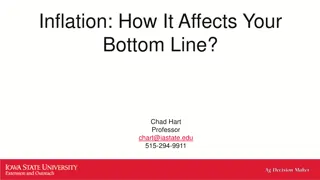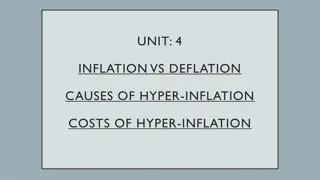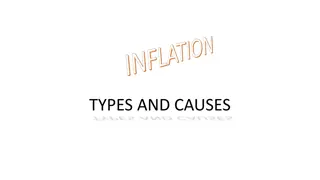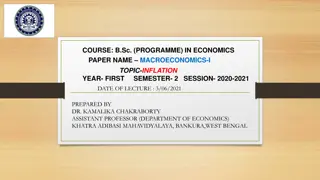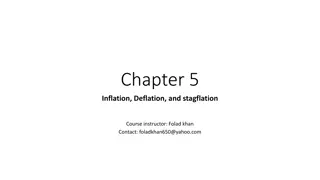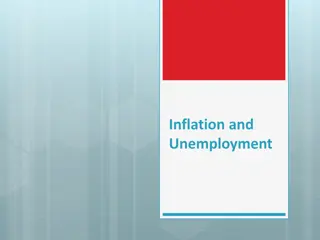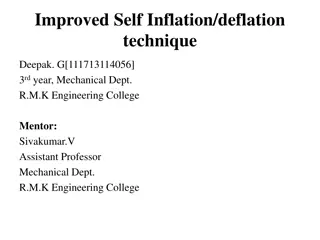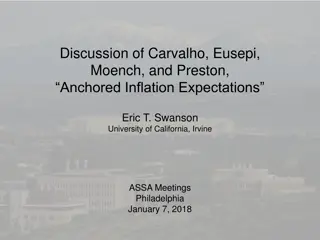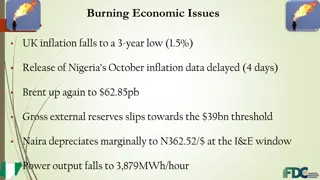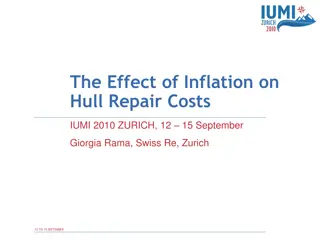Understanding the Costs of Inflation and Its Impact on Purchasing Power
Inflation is a crucial economic phenomenon with both winners and losers. While inflation itself doesn't necessarily reduce real purchasing power, it leads to various costs such as shoeleather costs, menu costs, and unit of account costs. These costs emerge due to the changing dynamics of prices, wages, and the value of money. It's essential to comprehend how inflation affects individuals and economies to navigate its implications effectively.
Download Presentation

Please find below an Image/Link to download the presentation.
The content on the website is provided AS IS for your information and personal use only. It may not be sold, licensed, or shared on other websites without obtaining consent from the author. Download presentation by click this link. If you encounter any issues during the download, it is possible that the publisher has removed the file from their server.
E N D
Presentation Transcript
Inflation MODULE 14
What you will learn in this Module: The economic costs of inflation How inflation creates winners and losers Why policy makers try to maintain a stable rate of inflation The difference between real and nominal values of income, wages, and interest rates The problems of deflation and disinflation
The Costs of Inflation: A Fall in Purchasing Power? INFLATION DOES NOT IN ITSELF REDUCE PEOPLE S REAL PURCHASING POWER.
The Level of Prices Doesnt Matter As price levels rise so do nominal wage rates This means that your real wage (what your income buys you) hasn t changed.
But the rate of inflation does Price level changes versus changes in the inflation rate Even though rises in the price level are met by increases in wages in the long term, short- run increases in the rate of inflation have costs
The Costs of Inflation Shoe leather costs Menu costs Unit of Account Costs
Shoeleather Costs Shoeleather costs are the resources wasted when inflation encourages people to reduce their money holdings. Inflation reduces the real value of money, so people have an incentive to minimize their cash holdings. In post WWI Germany store owners employed runners to take cash to the bank several times a day to convert it into something that would hold value, such as a foreign currency.
Menu Costs Menu costs are the costs of adjusting prices. During inflationary times, it is necessary to update price lists and other posted prices. In Argentina store owners locked their doors in the early afternoon to make price changes.
Unit of Account Costs Inflation causes our money to no longer be useful as a Unit of Account (used to explain relative value of goods, services and financial assets). This is because inflation distorts relative prices. Inflation exaggerates the size of capital gains and increases the tax burden on this type of income. An asset that earns 10% over its original price, during a period with a 10% inflation rate breaks even but would be taxed as a 10% increase in profit
Winners and Losers from Inflation Inflation affects individuals differently depending on their role in a financial transaction and whether or not the inflation was expected. To understand this we need to understand the difference between Real and Nominal Interest Rates Interest rates are the percentage of a loan that must be paid in addition to the loan amount. Interest rates represent a percentage of the current value of borrowed money (the real rate) plus an additional percentage to cover inflationary expectations.
Real and Nominal Interest Rates The nominal interest rate is the interest rate not corrected for inflation. It is the interest rate that a bank states. Nominal interest rate = (Real rate + expected The real interest rate is the nominal interest rate that is corrected for actual inflation. Real interest rate = (Nominal interest rate Inflation rate) inflation rate)
Real and Nominal Interest Rates You borrowed $1,000 for one year. Nominal interest rate was 15%. (The bank needed 10% to cover their costs and 5% to cover expected inflation) During the year inflation was 10%. Real interest rate = Nominal interest rate Inflation =15% - 10% = 5% The winner in this situation was the borrower who ultimately pays back money that is worth less than when it was borrowed. The bank is the loser; it is being repaid money that is worth less than when it was borrowed.
Real and Nominal Interest Rates Interest Rates (percent per year) 15 Nominal interest rate 10 5 0 Real interest rate -5 1998 1965 1970 1975 1980 1985 1990 1995
Whos Hurt? Whos Helped? By Unanticipated Inflation You re hurt if you are a Creditor the money you loan out is worth less when its paid back Saver inflation rates are normally higher than interest rates Fixed income receiver- a constant income will buy less. You re helped if you are a Borrower- the money you are repaying is worth less Flexible income earner- if your income is tied to profits you will earn more If your income is adjusted for inflation you will earn more (COLA) Payer of fixed amounts
Inflation is easy; Disinflation is hard Disinflation bringing the inflation rate down can cause high levels of unemployment. When the inflation rate reached 14% in the late 70s early 80s the Federal Reserve adopted disinflationary measures. The disinflation of the 1980s caused a severe recession with unemployment rates of 10.8%



